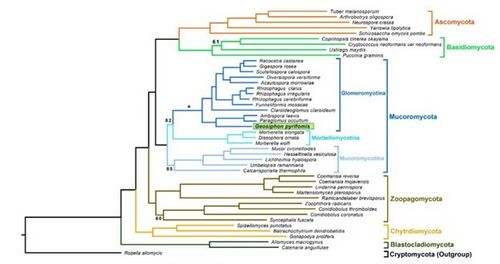Geosiphon-Nostoc Endosymbiosis
Classification
Higher order taxa
Domain: Bacteria, Phylum: Cyanobacteria, Class: Cyanophyceae, Order: Nostocales, Family: Nostocaceae, Genus: Nostoc
Domain: Fungi, Phylum: Mucoromycota, Class: Glomeromycetes, Order: Archaeosporales, Family: Geosiphonaceae, Genus: Geosiphon
Species
Nostoc punctiforme (ATTC: 29133) Geosiphon pyriformis (NCBI: 50956)
Description and significance
Nostoc punctiforme is a filamentous cyanobacterium that can be photoautotrophic, diazotrophic, heterotrophic, and/or symbiotic. This species of cyanobacteria has vegetative cells that can differentiate into heterocysts, spore-like akinetes, or motile filaments called hormogonia. This species is also broadly symbiotic, forming relationships with fungi, bryophytes, gymnosperms, and angiosperms. The genome contains a large number of unique genes that likely play essential roles in cell differentiation and symbiosis.- “An overview of the genome of Nostoc punctiforme, a multicellular, symbiotic cyanobacterium”
Geosiphon pyriformis is a glomeromycete fungus and obligate symbiont commonly found in soil. Glomeromycete fungi are usually arbuscular mycorrhizae that form a symbiotic relationship with vascular plants and brophytes. While most glomeromycete fungi form these arbuscular mycorrhizal (AM) relationships, Geosiphon pyriformis has not been observed in AM relationships with plants. Geosiphon pyriformis "may also be symbiotic with plants. If so an ecological network could exist among AMF, vascular plants, brophytes, and cyanobacteria, with extensive sharing and exchange among the symbiotic partners." (Schubler 2012)
16S Ribosomal RNA Gene Information
Nostoc- 9.5Mb, 41.5%GC, 7432 open reading frames, shotgun sequenced, “A significant part of the information of a genome resides outside of genes. Protein binding sites may determine the regulation of gene transcription and the compact structure of the genome within the cell. The modification state of DNA may regulate the replication of the genome and aid in DNA repair. Transposable elements and repeated sequences may increase the plasticity of the genome and contribute to rapid changes over evolutionary time. In each of these regards, the genome of N. punctiforme is strikingly different from those of most bacteria.” (An overview of the genome of Nostoc punctiforme, a multicellular, symbiotic cyanobacterium)

